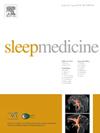Negative effects of cognitive behavioral therapy for insomnia: Psychometric evaluation of an insomnia-specific extension for the Negative Effect Questionnaire
IF 3.8
2区 医学
Q1 CLINICAL NEUROLOGY
引用次数: 0
Abstract
Introduction
Negative effects of psychotherapy encompass unwanted events caused by the treatment. Evidence exists that cognitive behavioral therapy for insomnia (CBT-I) can lead to negative effects (e.g., exhaustion, reduced motivation). Psychometrically validated instruments are needed to enable systematic investigation of negative effects and their consequences. This study aimed to develop an insomnia-specific extension for the Negative Effect Questionnaire (NEQ) and to evaluate its psychometric properties.
Method
Based on a literature review, an item pool was developed as an extension to the NEQ. This item pool was iteratively refined. Both the NEQ and the developed item pool were administered to participants enrolled in a stepped-care model for insomnia that includes an internet-delivered CBT-I. The psychometric properties of the item pool were evaluated using confirmatory factor analyses (CFAs). Additionally, responses to open-ended questions were categorized and analyzed.
Results
Data from 210 participants were available. In the newly developed item pool, participants reported a mean of 4.7 negative effects (range: 0 to 22). CFA indicated a good fit (RSMEA = 0.05; SRMR = 0.07) of a model with five latent factors (somatic symptoms, cognitive symptoms, safety, emotional symptoms, daytime functioning). The correlation analyses between the model's latent factors and the NEQ subscales indicated adequate discriminant validity.
Discussion
The observed prevalence rates of insomnia-specific negative effects highlight the need to assess the negative effects of CBT-I with an insomnia-specific instrument. The CFA suggests that the 24-item NEQ-Insomnia is a valid instrument, suitable for standalone use or as an extension to the NEQ for assessing the negative effects of CBT-I.

求助全文
约1分钟内获得全文
求助全文
来源期刊

Sleep medicine
医学-临床神经学
CiteScore
8.40
自引率
6.20%
发文量
1060
审稿时长
49 days
期刊介绍:
Sleep Medicine aims to be a journal no one involved in clinical sleep medicine can do without.
A journal primarily focussing on the human aspects of sleep, integrating the various disciplines that are involved in sleep medicine: neurology, clinical neurophysiology, internal medicine (particularly pulmonology and cardiology), psychology, psychiatry, sleep technology, pediatrics, neurosurgery, otorhinolaryngology, and dentistry.
The journal publishes the following types of articles: Reviews (also intended as a way to bridge the gap between basic sleep research and clinical relevance); Original Research Articles; Full-length articles; Brief communications; Controversies; Case reports; Letters to the Editor; Journal search and commentaries; Book reviews; Meeting announcements; Listing of relevant organisations plus web sites.
 求助内容:
求助内容: 应助结果提醒方式:
应助结果提醒方式:


